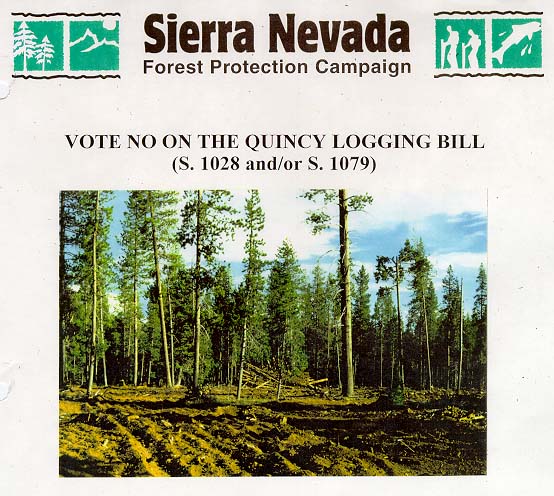
This flyer was distributed to the Senate and media during the week of February 16-20, 1998. The Facts are provided below.

A Clearcut Is a Clearcut
Advocates of the Quincy logging bill imply that the style of logging mandated by the bill would be sensitive to the environment. This 1997 clearcut on the Lassen National Forest is part of a so called "defensible fuel profile zone" project. The Quincy Logging bill's mandate to log up to 60,000 acres of fuel profile zones, and more than 9,000 additional acres of "group selection" clearcuts up to 2 acres in size could result in ecological fragmentation of much or the northern Sierra.
The Facts according to the QLG
The sale unit depicted is actually from the Star and/or Dillon Windthrow Salvage Sales on the Almanor Ranger District of the Lassen National Forest. This salvage sale was intended to recover the economic value of the of the trees blown down by a severe windstorm which occurred during the winter of 1996.
While these locations are indeed overlainby the Bailey Creek Forest Health Pilot Project (one of the projects funded by the $4.7 million additional funds sent to the QLG-area Forests by USDA), they do not accurately represent QLG management there. In fact, the Bailey Creek Forest Health Pilot sales have only recently been sold and have not been implemented yet.
The QLG perception of a DFPZ would result in crown closure of 30 to 40 percent (See the QLG Fuel Break Strategy white paper).
Sierra Nevada Ecosystem Project
Scientists describe DFPZs as a fairly open stand, dominated
mostly by larger trees of fire-tolerant species. DFPZs need not
be uniform, however, but may encompass considerable diversity in
ages, sizes, and distributions of trees. The key features should
be the general openness and discontinuity of crown fuels, both
horizontally and vertically, producing a very low probability of
sustained crown fire. Similarly, edges of DFPZs need not be
abrupt but can be 'feathered' into the adjacent forest.
Post-treatment canopy closure usually should be no more than 40%,
although adjustments in stand density based on local conditions
certainly are appropriate. In some areas, for example, greater
canopy closure may be desirable to slow encroachment by highly
flammable shrubs or other understory vegetation, so long as tree
crowns are high enough that a sustained crown fire in the denser
canopy is very unlikely."
Weatherspoon, C. Phillip and
Skinner, Carl N. Landscape-Level Strategies for Forest Fuel
Management. Sierra Nevada Ecosystem Project: Final Report to
Congress, vol. II, Assessments and scientific basis for
management options, Davis: University of California, Centers for
Water and Wildland Resources, 1996. Chap.56, p. 1482
January ,(, /),( 0(:,( AM